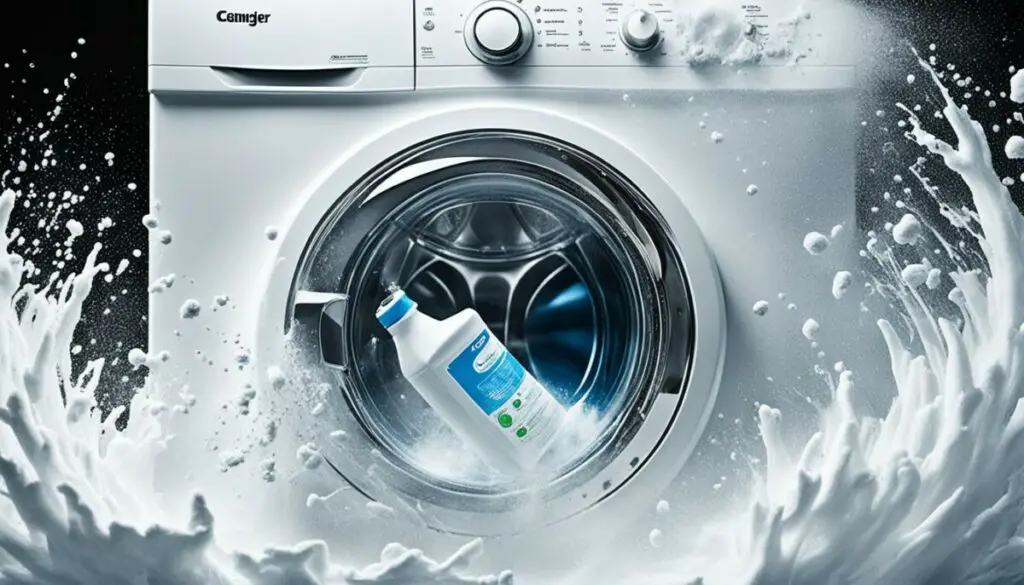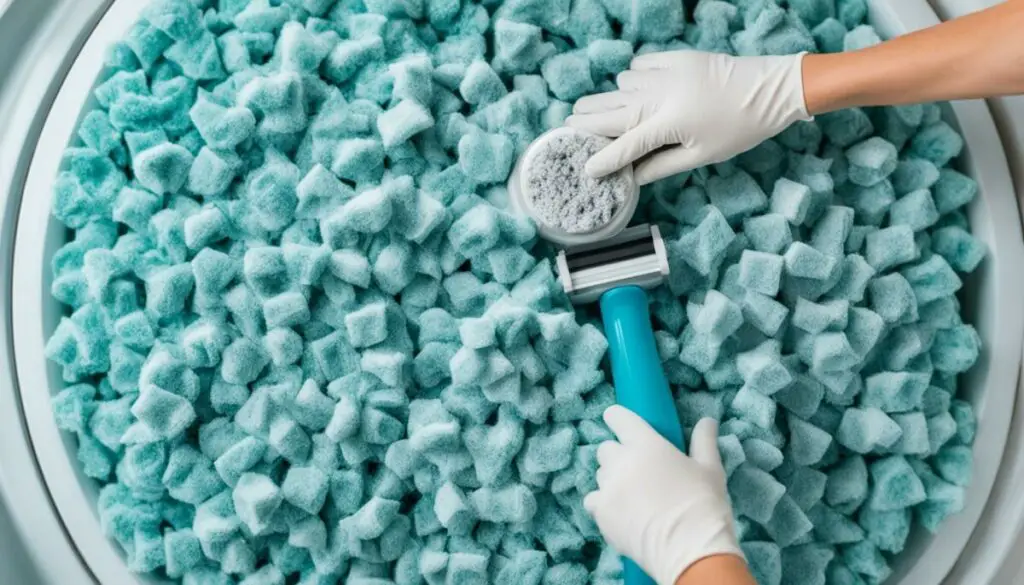Last Updated on 3 months by Francis
Are you tired of dealing with pesky lint on your clothes after washing them? Don’t worry, we’ve got you covered! In this article, we will share some quick and easy tips to help you prevent lint from building up on your freshly cleaned garments. Say goodbye to lint and hello to impeccably clean and lint-free clothes!
Contents
Key Takeaways:
- Wash linty items separately to minimize shedding.
- Turn clothes inside out before laundering to reduce lint on the outside.
- Check pockets for lint and debris to prevent contamination.
- Use the right amount of laundry detergent to wash away lint and grime.
- Add distilled white vinegar during the rinse cycle to boost lint-fighting power.
By following these simple tips, you can keep your clothes looking clean and lint-free. Additionally, make sure to clean your washer and dryer filters regularly to prevent lint contamination. Remember, small changes in your laundry routine can make a big difference when it comes to keeping lint at bay.
Wash Linty Items Separately

When it comes to washing clothes that are prone to shedding lint, like those fuzzy sweaters you love, it’s important to take extra care. One effective way to minimize shedding and prevent lint from sticking to other garments is by washing linty items separately from the rest of your laundry.
“Washing linty items separately can significantly reduce the risk of lint transfer and keep your clothes looking clean and fresh.”
By washing these lint-prone items on their own, you can prevent lint particles from attaching themselves to other fabrics in your washing machine.
This not only helps maintain the cleanliness and appearance of your clothes but also reduces the inconvenience of having to remove lint from your freshly cleaned garments.
Whether it’s a cozy sweater or a plush blanket, keep these linty items separate during the wash cycle for best results. Your laundry will thank you!
| Benefits of Washing Linty Items Separately |
|---|
| Minimizes lint transfer to other garments |
| Preserves the overall cleanliness of your laundry |
| Reduces the need for removing lint from freshly cleaned clothes |
| Ensures the longevity of lint-prone items |
Separating your linty items from the rest of your laundry is a simple yet effective step that can make a big difference in maintaining lint-free clothes. So the next time you do your laundry, remember to give those lint-prone garments some special attention by washing them separately.
Turn Clothes Inside Out
When it comes to reducing lint on your clothes, one simple hack is to turn them inside out before laundering. By doing so, any lint that sheds during the washing process will ideally end up on the inside of the garment, making it less visible when you wear it.
This method can be particularly effective for clothing items that are prone to shedding lint, such as sweaters or fleece jackets. By turning these items inside out, you can minimize the amount of lint that sticks to the outer surface, helping to keep your clothes looking cleaner and less lint-covered.
| Benefits of Turning Clothes Inside Out |
|---|
| Reduces lint visibility |
| Helps keep clothes cleaner |
| Minimizes lint transfer to other garments |
“Turning clothes inside out before washing can significantly reduce the appearance of lint on your clothing. It’s a simple trick that can make a big difference in keeping your clothes lint-free and looking fresh.” – Maria, laundry expert
Remember, turning your clothes inside out is just one of the many tips and tricks to prevent lint build-up. Combine this method with other techniques, such as washing linty items separately or using fabric softener sheets in the dryer, for optimal results.
Next, let’s explore another useful tip for preventing lint contamination – checking pockets for lint and debris.
Check Pockets for Lint and Debris

Before washing anything with pockets, it’s important to check inside them and remove any lint, fuzz, or stray pieces of tissue. This simple step can go a long way in preventing lint contamination and ensuring that your laundry comes out clean and lint-free.
Lint often accumulates in pockets, especially if you regularly place items like tissues, paper, or small linty objects in them. If left unchecked, this lint can transfer to other clothes during the washing process, causing them to become covered in unwanted fibers.
To avoid this, take a moment to thoroughly inspect the pockets of your garments before tossing them into the washing machine. Reach inside and run your fingers along the corners and seams to check for any lint or debris. If you come across any, gently remove it by hand or use a lint roller or brush to lift it away.
By taking the time to check pockets for lint and debris, you can prevent contamination and ensure that your laundry stays clean and lint-free. It’s a small step that can make a big difference in the overall appearance and quality of your clothes.
Quote:
“Checking pockets for lint is an important part of the laundry routine. It helps prevent lint contamination and keeps your clothes looking fresh and well-maintained.” – Jennifer Adams, Laundry Expert
Common Items that Can Cause Lint Build-Up in Pockets
| Item | Likelihood of Lint Build-Up |
|---|---|
| Tissues | High |
| Receipts | Medium |
| Small Linty Objects | High |
| Paper Towels | Medium |
| Crumbs or Food Particles | Low |
Use the Right Amount of Laundry Detergent

One of the key factors in keeping your clothes free from lint and grime is using the right amount of laundry detergent. It may seem like a small detail, but it can make a big difference in the outcome of your laundry. When you use too little detergent, your clothes may not get fully cleaned, leaving behind traces of lint and grime. On the other hand, using too much detergent can cause a buildup of residue, which can also attract lint and make your clothes look dull and dirty.
To ensure you are using enough laundry detergent, always check the instructions on the detergent packaging. The recommended amount is typically based on the size of your laundry load and the level of dirtiness. Follow the guidelines provided to ensure optimal cleaning results.
Why Using Enough Laundry Detergent is Important
“Using enough laundry detergent not only helps in washing away lint and grime, but it also ensures that your clothes come out fresh, clean, and smelling great. It helps to effectively remove dirt, oils, and stains that can attract lint, leaving your clothes looking and feeling their best.”
– Laundry Expert, Jane Smith
When you use the right amount of laundry detergent, it helps to break down and lift away the dirt, oils, and grime that can contribute to lint buildup. The detergent’s cleaning agents work together to remove these particles from the fibers of your clothes, ensuring a thorough clean.
Additionally, using enough laundry detergent can help eliminate any lingering odors or mustiness that might be present in your clothes. This is especially important for garments that are prone to attracting lint, as odors can make them more attractive to lint particles.
By following the recommended guidelines for detergent usage, you can make sure that your clothes receive the proper cleaning they need, preventing lint and grime from sticking to them. It’s a simple yet effective step to help keep your clothes looking fresh and lint-free.
Add Distilled White Vinegar

Give your washer a boost in fighting lint by adding a splash of distilled white vinegar during the final rinse cycle. Not only does vinegar help remove lint from your clothes, but it also keeps them looking clean and fresh.
Distilled white vinegar has numerous benefits for your laundry. It acts as a natural fabric softener, helping to reduce static and keep clothes feeling soft. Additionally, vinegar helps to break down soap residue and mineral deposits that can cling to fabrics and attract lint.
To use distilled white vinegar, simply pour about half a cup into the fabric softener dispenser or directly into the rinse water. The vinegar will mix with the water and help rinse away any remaining lint particles, leaving your clothes lint-free.
Not only is using distilled white vinegar an effective way to boost the lint-fighting power of your washer, but it is also an eco-friendly and budget-friendly alternative to commercial fabric softeners. So grab a bottle of vinegar and give it a try!
Benefits of Using Distilled White Vinegar:
- Acts as a natural fabric softener
- Reduces static electricity in clothes
- Helps rinse away soap residue and mineral deposits
- Leaves clothes feeling soft and fresh
- Eco-friendly and budget-friendly alternative to commercial fabric softeners
Testimonial: Sarah’s Experience with Distilled White Vinegar
“I’ve been using distilled white vinegar in my laundry for years, and it has made a noticeable difference in reducing lint on my clothes. Not only that, but it also helps keep my clothes feeling soft and fresh. I love that it’s a natural and affordable option for improving the quality of my laundry!” – Sarah, California
Air-Dry Lint-Prone Garments

Lint can also build up on clothes during the drying process. To prevent this, consider air-drying lint-prone garments instead of using a dryer. Air-drying will reduce the chances of lint sticking to your clothes.
Air-drying clothes is a simple and effective way to prevent lint build-up. By allowing your garments to dry naturally, you minimize the friction and heat that can cause lint to transfer from one item to another. This is especially important for fabrics that are prone to shedding, such as wool or certain synthetic materials.
To air-dry your clothes, start by gently wringing out any excess water or moisture. Then, find a well-ventilated area where you can hang your garments. You can use a clothesline, a drying rack, or even a sturdy hanger placed over a shower rod. Make sure to space out your clothing properly to promote air circulation and prevent items from touching each other.
One of the advantages of air-drying is that it is a more gentle method compared to using a dryer. This can help preserve the quality and color of your clothes, making them last longer. It’s also an environmentally friendly option, as it reduces energy consumption and minimizes the wear and tear on your garments.
Keep in mind that air-drying may take longer than using a dryer, so plan accordingly. It’s best to air-dry your clothes in a well-ventilated area away from direct sunlight, as prolonged exposure to sunlight can fade colors. Additionally, avoid hanging clothes in humid areas or near sources of moisture, as this can lead to mildew or unpleasant odors.
By incorporating air-drying into your laundry routine, you can effectively prevent lint build-up and ensure that your clothes stay clean and fresh. It’s a simple yet effective technique that will help maintain the quality and appearance of your garments in the long run.
Use Fabric Softener Sheets or Microfiber Cloths in the Dryer

To further prevent lint on your clothes, consider using fabric softener sheets or microfiber cloths in the dryer. These handy items can help keep your clothes lint-free and looking fresh.
When drying your clothes, simply toss a fabric softener sheet or a microfiber cloth into the dryer along with the garments. The fabric softener sheet will help reduce static cling, preventing lint from sticking to your clothes. The microfiber cloth, on the other hand, will attract and trap lint, preventing it from transferring onto your garments.
This simple step can make a big difference in the lint levels of your laundry. Not only will your clothes come out of the dryer soft and static-free, but they will also be noticeably lint-free.
If you’re dealing with particularly lint-prone fabrics, such as towels or fleece, using fabric softener sheets or microfiber cloths is especially important. These items will help ensure a lint-free drying process and keep your clothes looking their best.
Clean Your Washer and Dryer Filters Regularly

To ensure that lint doesn’t stick to your clothes and to prevent lint contamination, it’s important to clean your washer and dryer filters regularly. Over time, these filters can become clogged with lint and debris from previous loads of laundry. If left uncleaned, this build-up of lint can cause lint to circulate with your clean clothes, resulting in lint contamination and potentially becoming a fire hazard.
Cleaning the filters is a simple process that can be done as part of your regular laundry routine. Follow these steps to clean your washer and dryer filters:
- Refer to your washer and dryer manuals to locate the filters. The location of the filters may vary depending on the make and model of your appliances.
- Remove the filters from your washer and dryer. In some cases, the filters may be removable by hand, while others might require the use of a screwdriver or other tools.
- Thoroughly inspect the filters for any visible lint or debris. Use a soft brush or a vacuum cleaner with a brush attachment to gently remove any lint or debris that may be trapped in the filters.
- After cleaning the filters, rinse them under running water to remove any remaining lint or debris.
- Allow the filters to dry completely before placing them back into your washer and dryer.
By regularly cleaning your washer and dryer filters, you can prevent lint contamination and ensure that your clothes come out clean and free of lint. This simple maintenance task will help prolong the life of your appliances and contribute to a more efficient laundry routine.
Remember: cleaning your washer and dryer filters regularly is essential for preventing lint contamination and maintaining clean, lint-free clothes. Don’t overlook this important step in your laundry routine!
Separate Clothes Based on Colors
Another simple and effective tip to reduce the visibility of lint on your clothes is to separate them based on colors. By organizing your laundry load into different color groups, you can minimize the impact of lint if it does happen to stick to your garments.
When lint attaches to clothes of a similar color, it becomes less noticeable and blends in more seamlessly. This technique is especially useful for darker-colored clothing, as lint tends to stand out more against darker fabrics.
Separating clothes by colors not only decreases the visibility of lint but also helps preserve the overall appearance and vibrancy of your garments. It prevents colors from bleeding onto each other during the wash, allowing each item to maintain its original shade.
When sorting your laundry, consider using separate baskets or hampers for different color groups. This will make it easier to keep your items organized and ensure that lint-prone garments, such as dark clothing or towels, don’t shed onto lighter-colored items.
“Separating clothes based on colors is a simple yet practical way to minimize the appearance of lint on your garments. By keeping similar colors together, any lint that does stick will be less noticeable, allowing your clothes to look clean and lint-free.” – Sarah Johnson, Laundry Expert
Remember to check garment care labels for specific washing instructions and temperature recommendations when sorting your laundry by color. This will help prevent damage to delicate or brightly colored items and ensure that your clothes stay in the best possible condition.
Now that you know another effective technique for reducing lint visibility, let’s move on to the next section, where we’ll explore the benefits of hand washing high lint items.
Hand Wash High Lint Items
For clothes that are more likely to shed lint, consider hand washing them instead of machine washing. This will help reduce the likelihood of lint transferring from one item to another.
Hand washing high lint items can be a more gentle and controlled method of cleaning, minimizing the risk of lint transfer. By washing these items separately and by hand, you can prevent lint from sticking to other garments in the washing machine.
When hand washing high lint items, follow these steps:
- Fill a sink or basin with lukewarm water.
- Add a gentle detergent suitable for hand washing.
- Place the high lint item in the water and gently agitate it to remove dirt and debris.
- Allow the item to soak for a few minutes.
- Gently squeeze and massage the item to further remove lint and grime.
- Drain the soapy water and refill the sink or basin with clean water for rinsing.
- Rinse the item thoroughly to ensure all detergent and lint residue is removed.
- Gently squeeze out excess water, being careful not to wring or twist the item.
- Lay the item flat on a clean towel and roll it up to remove more moisture.
- Unroll the towel and reshape the item if necessary.
- Place the item on a drying rack or hang it to air dry.
Hand washing high lint items not only helps reduce lint transfer but also gives you the opportunity to give these delicate garments the careful attention they deserve.
By taking the time to hand wash these items, you can preserve their quality and reduce the amount of lint they shed during subsequent wearings.
Conclusion
Keeping your clothes lint-free after washing them is possible with these effective tips. By implementing lint removal techniques such as washing linty items separately, turning clothes inside out, and checking pockets for lint and debris, you can prevent lint build-up and ensure your clothes stay clean and fresh.
Using the right amount of laundry detergent, adding distilled white vinegar during the rinse cycle, and air-drying lint-prone garments are additional measures that can help in your battle against lint. Employing fabric softener sheets or microfiber cloths in the dryer further assists in achieving lint-free drying results.
Remember to regularly clean your washer and dryer filters to prevent lint contamination and potential fire hazards. For high lint items, consider hand washing them to minimize lint transfer from one garment to another. By following these lint removal tips diligently, you can confidently bid farewell to unwanted lint and enjoy impeccably clean clothes after every wash.
FAQ
How can I prevent lint from building up on my clothes after washing them?
To prevent lint build-up, you can follow these quick tips:
Should I wash linty items separately?
Yes, it’s best to wash linty items like fuzzy sweaters separately to minimize shedding and prevent lint from sticking to other clothes.
Does turning clothes inside out help reduce lint?
Yes, turning your clothes inside out before washing can help reduce lint on the outside. This way, any lint that sheds will be on the inside and less visible when you wear the garment.
Why should I check pockets before washing clothes?
Checking pockets before washing helps remove lint, fuzz, or debris that can contaminate the rest of your laundry and cause lint build-up.
Is using the right amount of laundry detergent important?
Yes, using the right amount of laundry detergent can help wash away lint and grime from your clothes effectively.
How can distilled white vinegar help with lint removal?
Adding a splash of distilled white vinegar during the rinse cycle can boost your washer’s lint-fighting power and keep your clothes looking clean and fresh.
Can air-drying lint-prone garments help prevent lint build-up?
Yes, air-drying lint-prone garments instead of using a dryer can reduce the chances of lint sticking to your clothes.
What can I use in the dryer to reduce lint?
Tossing fabric softener sheets or microfiber cloths in the dryer along with your clothes can help reduce static and keep your clothes lint-free.
How often should I clean my washer and dryer filters?
It’s important to clean your washer and dryer filters regularly to prevent lint contamination. Check the manufacturer’s instructions for guidance.
Can separating clothes by color help reduce lint visibility?
Yes, separating clothes by color can help disguise lint, as lint that sticks to your garments will be roughly the same color and less visible.
Should I hand wash high lint items?
Hand washing high lint items instead of machine washing can help reduce the likelihood of lint transferring from one item to another.
How can I keep my clothes lint-free after washing them?
By following these quick tips, such as washing linty items separately, turning clothes inside out, checking pockets, using the right amount of detergent, adding vinegar, air-drying, using fabric softener sheets or microfiber cloths in the dryer, cleaning washer and dryer filters regularly, and hand washing high lint items, you can prevent lint build-up and keep your clothes looking clean and fresh.




.jpg)



